The COVID-19 pandemic has impacted the U.S. economy and workforce in unprecedented ways; according to experts, the fallout could last for years.
In May 2020, the Bureau of Labor Statistics reported that the unemployment rate was 13.3%. However, according to some metrics, the unemployment rate might actually be closer to 16%, with approximately 30 million Americans currently unemployed. Either way, this is a significant increase from the February 2020 unemployment rate, which was 3.5%.
Amidst this economic disruption and uncertainty, we partnered with YouGov, a leading authority in public opinion data, to survey 3,786 Americans aged 18-55+ about their employment status, and what, if anything, they are doing to remain competitive in a tough job market.
The COVID-19 pandemic has affected employment for 30% of American workers
According to our survey, 15.6% of respondents had their hours reduced in the wake of the pandemic; 7.6% were laid off; 7.2% were furloughed, and 2.3% quit their jobs.
Younger Americans were also more likely than older Americans to experience employment changes. Nearly one-fourth (23.3%) of 18-34 year-olds had their hours reduced, compared to 18.7% of 35-54 year-olds, and 7.6% of individuals 55 and older. Twelve percent of 18-34 year-olds were laid off, compared to 7.6% of 35-54 year-olds, and 4.3% of individuals 55 and older.
When sorted by income level, middle-class workers were the most affected; 19.3% of workers who make $40,000-$80,000 annually had their hours reduced, compared to 13.7% of employees who make less than $40,000, and 17% of employees who make more than $80,000.
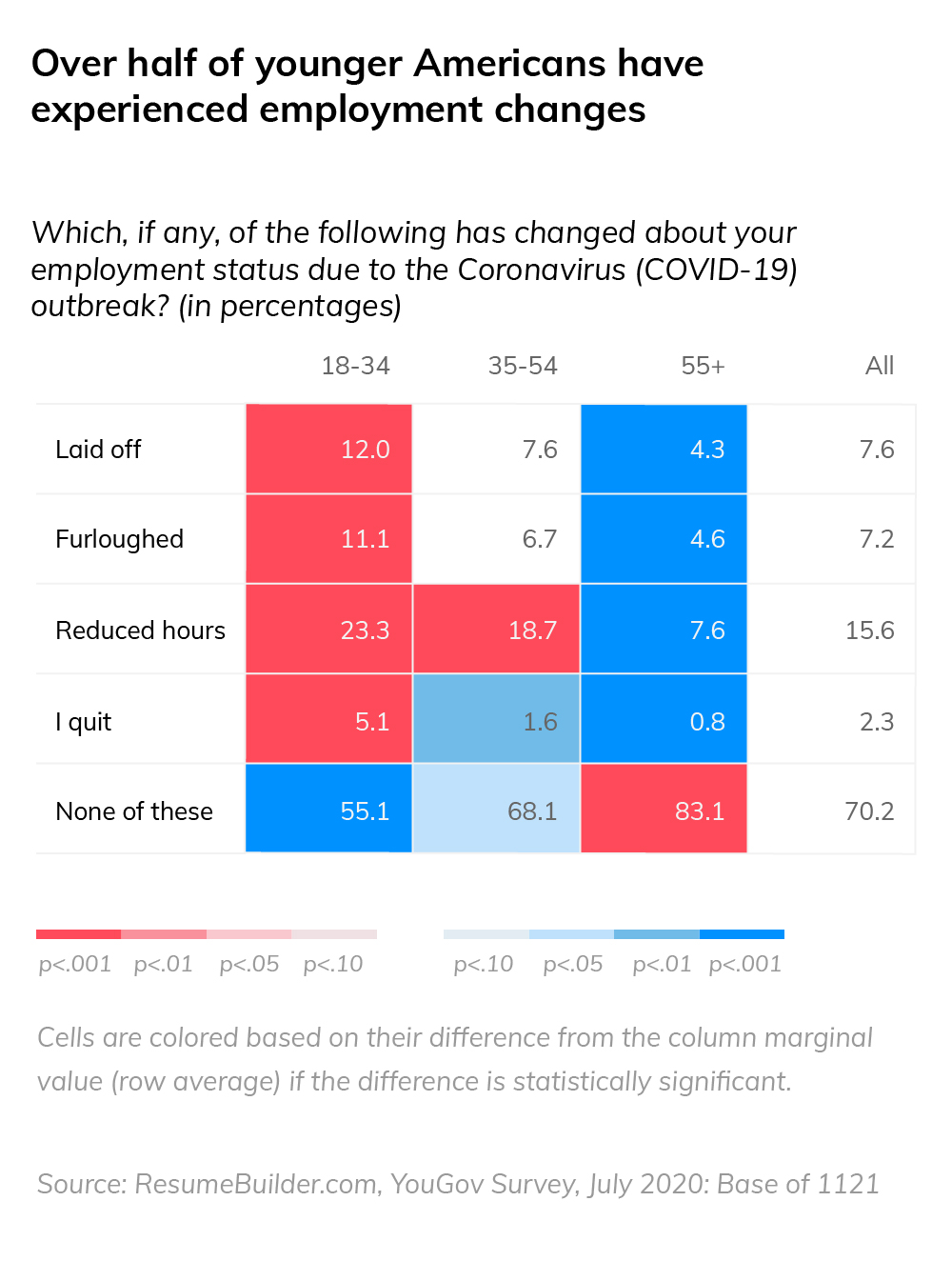
Hispanics were almost twice as likely as whites to be laid off during the pandemic
Overall, 47.9% of Hispanics experienced a change in employment status, compared to 37.1% of Blacks, and 26.9% of whites. Hispanics experienced layoffs at nearly twice the rate of whites (11.4% compared to 6.3%). Furlough rates are also nearly twice as high for Hispanics as they are for whites (10% compared to 5.8%).
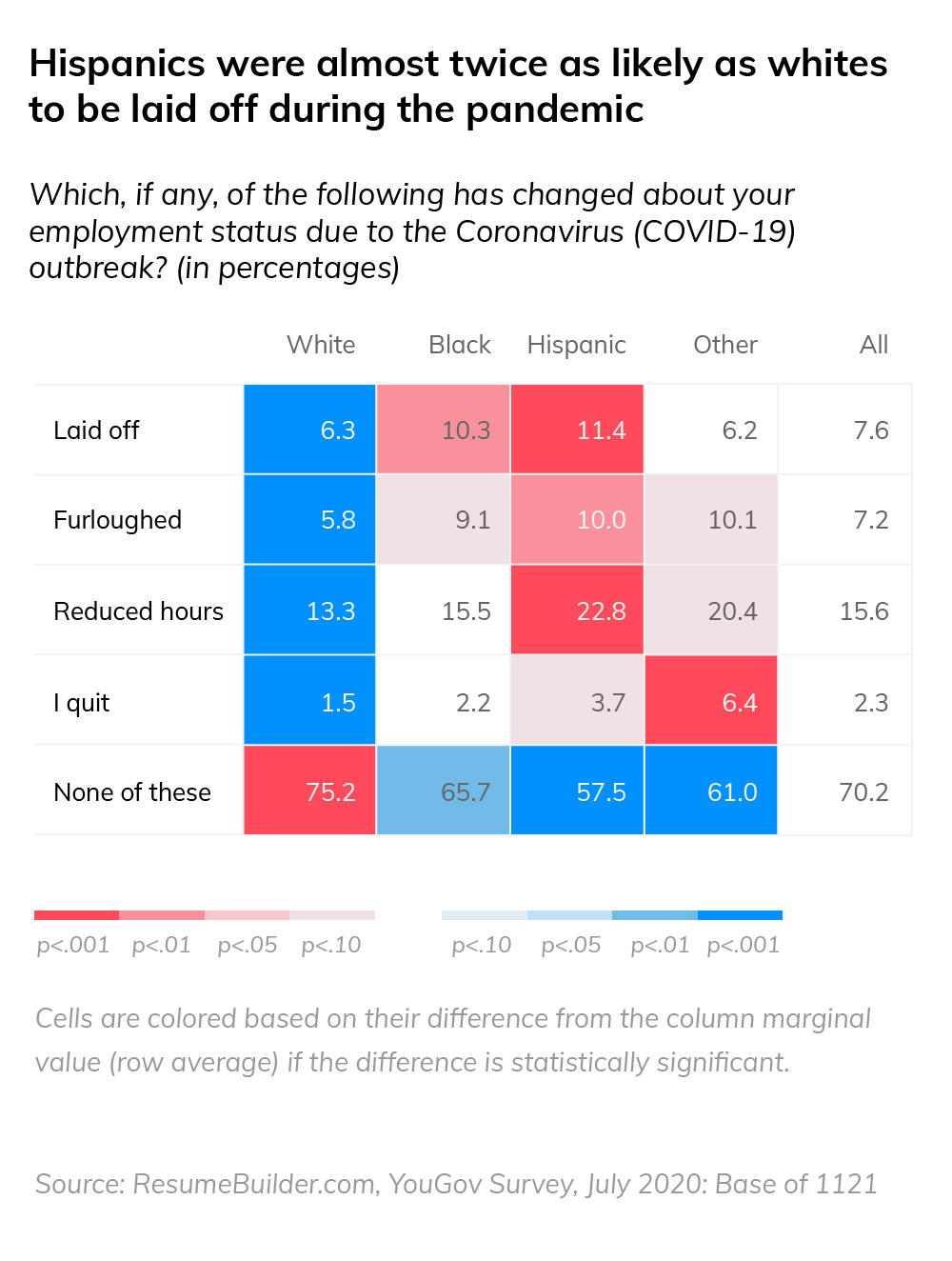
Almost 25% of Americans say there are no suitable employment opportunities
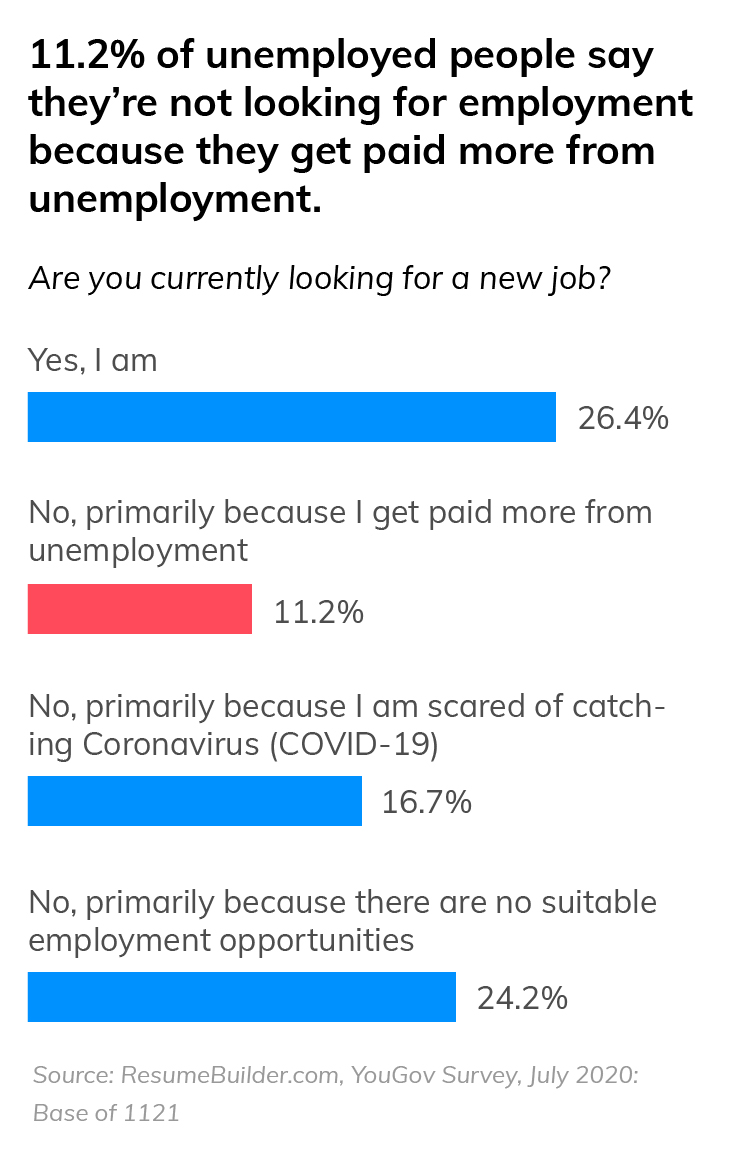
Of all the people surveyed, only 26.4% said they are currently looking for a new job. Among the three-quarters who are not, 24.2% said it is because there are no suitable job opportunities. Indeed, many industries have been severely impacted by pandemic-related shutdowns, including hospitality, food service, health care, retail, government, and construction fairing the worst.
For 16.7% of respondents, fears of COVID-19 exposure are the primary reason they are not job-searching, while 11.2% of respondents said that they are earning more from unemployment.
Younger Americans are twice as likely as older Americans to be seeking a new job
Nearly 32% of 18-34 year-olds are actively seeking new employment, compared to 15.9% of individuals 55+, and 26.1% of 35-54 year-olds. However, when it came to reasons why people are not job-hunting, 19.3% of 18-34 year-olds said it is because they are scared of contracting COVID-19, compared to 15.7% of individuals aged 55 and older.
Survey respondents from different regions have different reasons for why they are not job-hunting. In the West, 15.1% of people said they are earning more on unemployment, compared to 9.6% of people in the South, 10.1% in the Midwest, and 10.4% in the Northeast. In the Midwest, only 12.7% of respondents said they aren’t looking for new jobs because of COVID-19 fears, compared to 17.2% in the Northeast, 18.2% in the South, and 17% in the West.
Income level also plays a role in whether individuals are actively seeking employment. Among people who make less than $40,000 per year, 13.3% said they are not looking for a new job because they are earning more on unemployment.
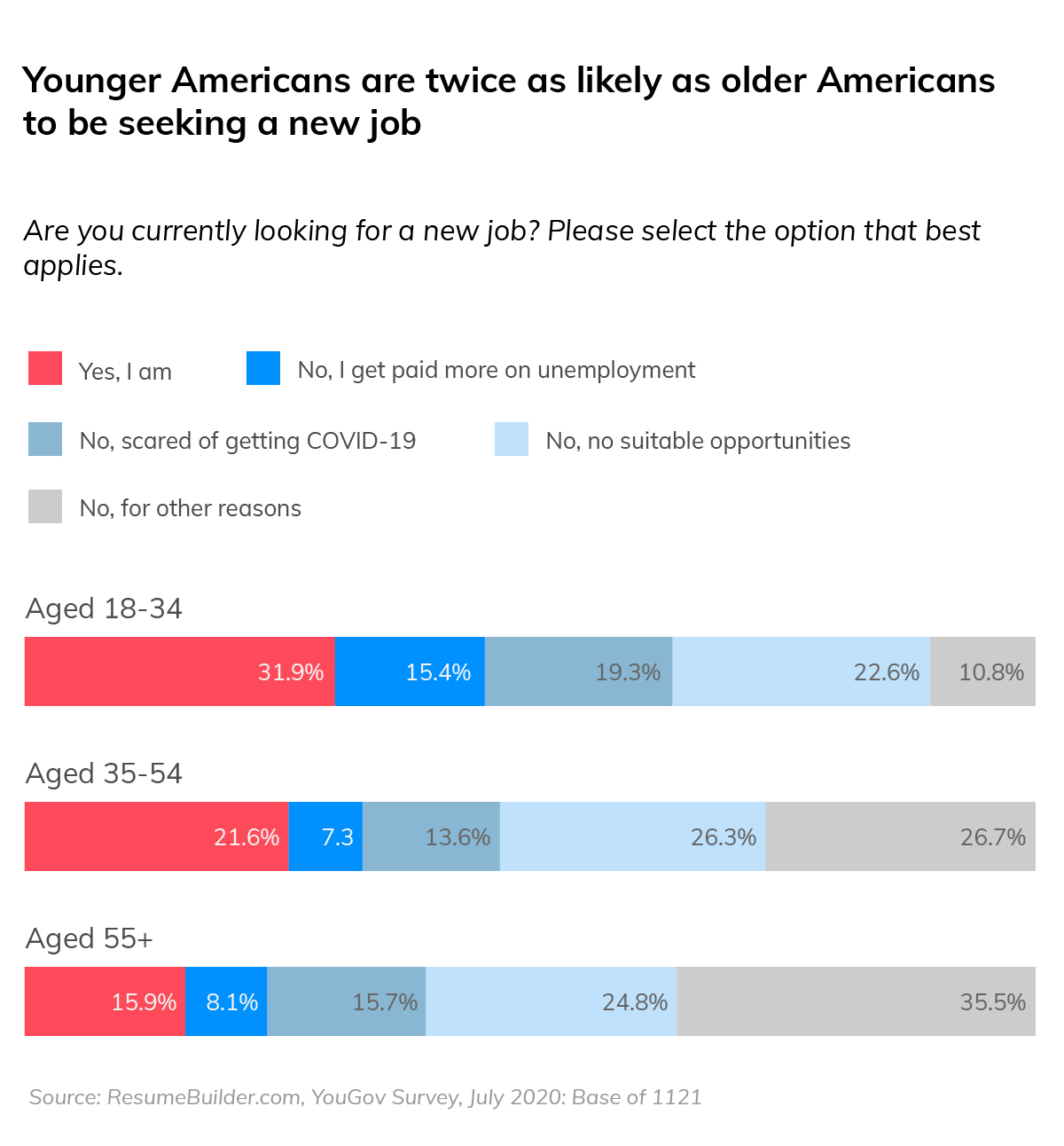
Only 32% of Americans feel strongly that their resume has the necessary skills to be competitive in the job market given high unemployment rates
Men are more likely than women to believe that their resumes are job-hunt ready; 79.7% of male respondents expressed confidence in their resume, compared to 67% of women. Men are also slightly more likely to believe that their resume has the necessary skills to allow them to change careers (76.2% compared to 66.8%).
Eighty percent of 35-54 year-olds are confident that their resume displays the necessary skills to be competitive in a tough job market, compared to 73.1% of 18-34 year-olds, and 67.7% of workers 55+. Only 61% of people aged 55 and older said their resumes would support a career change, compared to 75.1% of 18-34 year-olds, and 75.3% of 35-54 year-olds.
According to our data, there is also a correlation between education and confidence in a resume. Among those who strongly agree that they have the necessary skill set to be competitive in the current job market, 44.7% have a postgraduate degree; 37.5% have a 4-year degree; 31.6% have a 2-year degree or some college education, and 27.2% have a high school education.
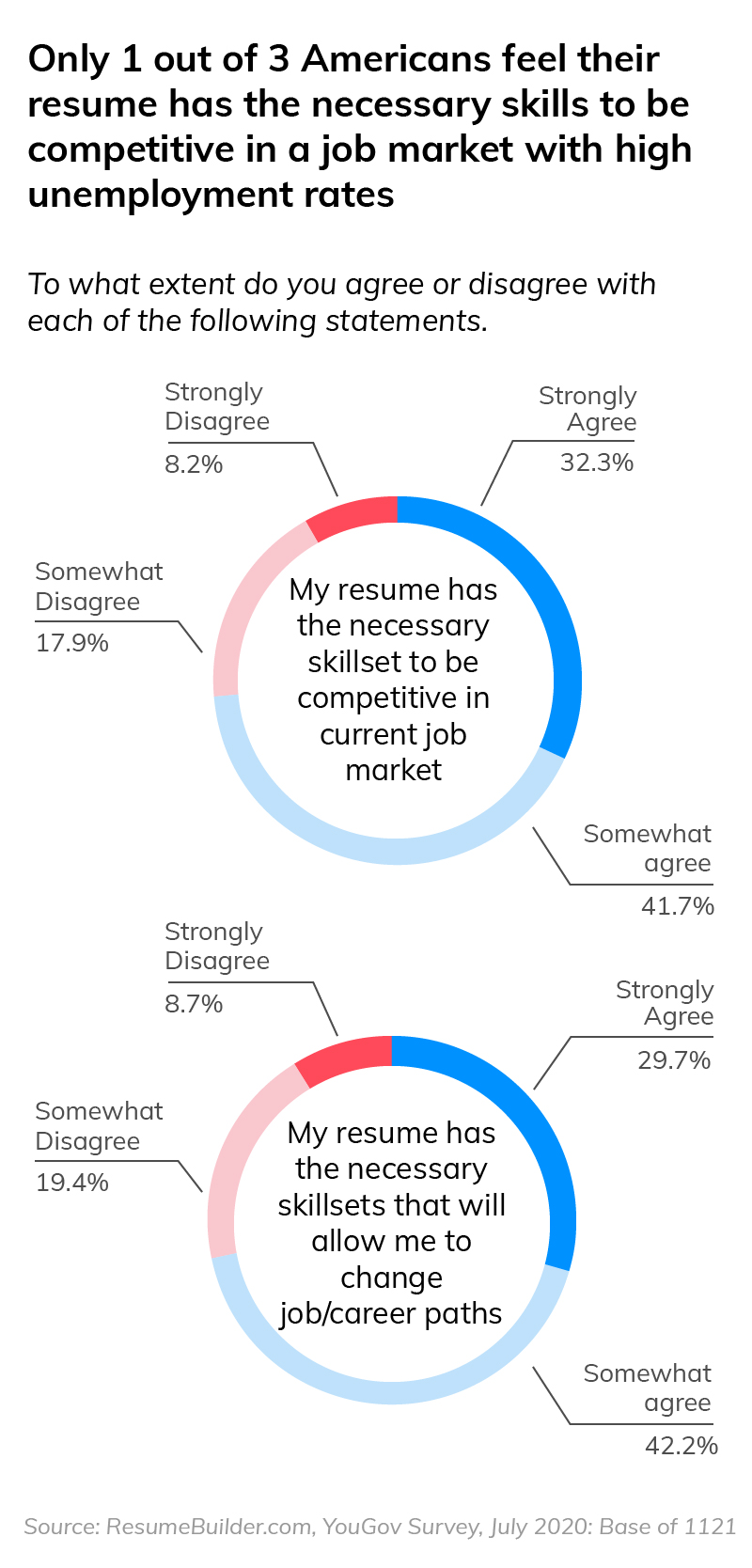
Almost 27% of American workers are looking for employment outside of their current industry
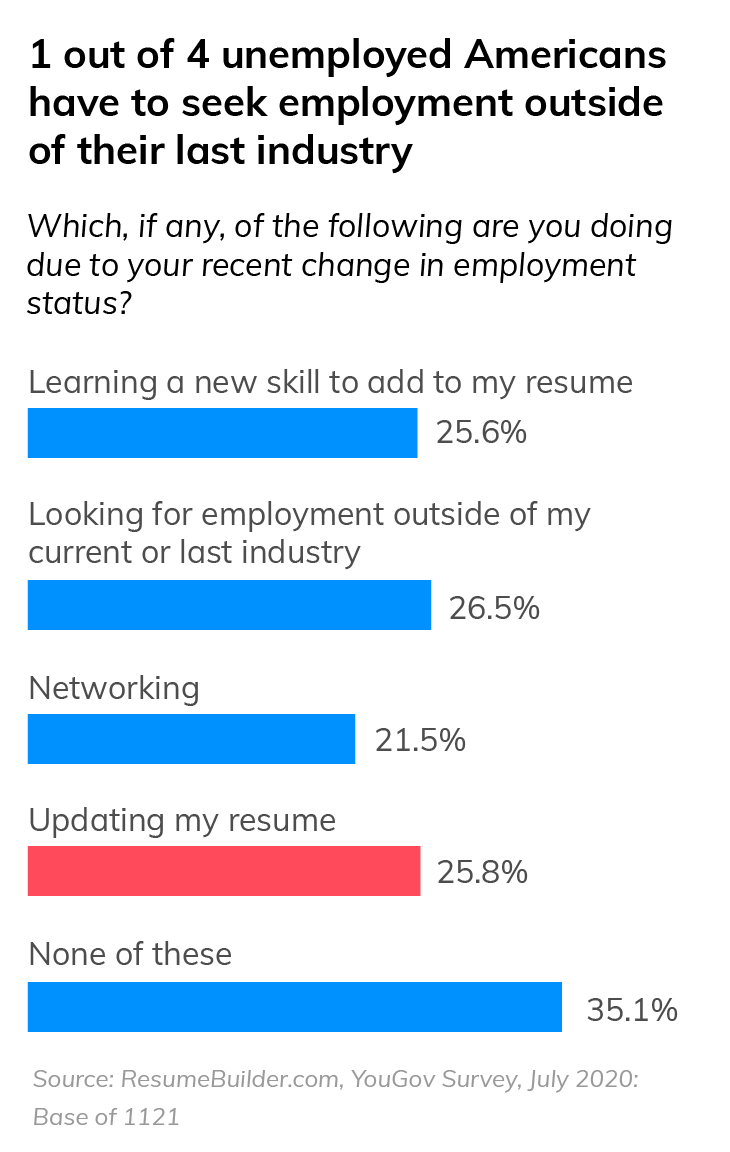
In order to address their change in employment status, slightly more than one-fourth of all workers are considering changing career paths. According to our survey, 31.5% of 18-34 year-olds are looking for employment outside of their current or previous industry, as are 24.8% of 35-54 year-olds, and 19% of those aged 55 and older.
Overall, older workers are more than twice as likely as younger workers to not be taking action to address changes in employment status; 58.3% of respondents aged 55 and older said they are not job-hunting, compared to 23.4% of 18-34 year-olds.
Income level does not seem to have a significant effect on whether workers are switching career paths. Only 29.8% of individuals who make less than $40,000 annually are job-searching outside their current or last industry, compared to 21.9% of those who make between $40,000 and $80,000, and 28.5% of those who make more than $80,000.
26% of American workers are learning a new skill to add to their resumes
In total, 51.4% of people who have experienced a change in employment status are working on their resumes; 25.6% of workers are learning new skills to add to their resumes, while 25.8% are revising and updating their resumes.
Despite the fact that more men than women believe that their resumes are ready for job-searching, 54.3% of men are updating their resumes, or learning new skills, compared to 47.9% of women.
Workers in different regions are handling their changes in unemployment status differently as well. In the Midwest, 43.6% of respondents said they are not taking any steps to address their change in unemployment status, compared to 31.8% of workers in the West; 33.2% in the Northeast, and 34.3% in the South.
5 Ways to Update Your Resume
1. Ask a friend or colleague to review and proofread your resume
Having an outside eye on your resume can help you identify omissions and unnecessary information, as well as ways to freshen up the content and layout. A trusted friend or colleague who is familiar with your work history may also be able to help you better quantify your skills and achievements. Once you’ve revised your resume, have someone proofread it for spelling and punctuation errors, to ensure it is as polished as possible.
2. Redesign your resume to optimize it for Applicant Tracking Systems
Applicant Tracking Systems (ATS) software doesn’t read text in headers, footers, charts, tables, text boxes, or photos. It also scans left-to-right, so it may not read text in columns accurately. Therefore, make sure that your resume is formatted so that the ATS software can easily identify relevant information. ATS software also scans for specific keywords based on the job description, so it’s a good idea to tweak your resume for each job before submitting it.
3. Swap out your career summary for a branding statement
The traditional style of including an objective or career summary at the beginning of your resume is giving way to the newer approach of a branding statement. Instead of focusing on what you want, an effective branding statement introduces you to potential employers by highlighting the value that you bring to them. Use this short paragraph (4-6 sentences) to describe your strongest skills, and demonstrate the unique value that you will bring to a company.
4. Streamline your work history timeline
While you obviously want your resume to demonstrate the breadth and depth of your professional experience, a resume that is overloaded with outdated and irrelevant experience can actually work against you. Depending on how long your work history is, it may be beneficial to delete older, short-term, or irrelevant jobs. However, be mindful of employment gaps, because ATS software and HR teams look for consistent work history. A workaround is to only list years of employment, not months.
5. Address COVID-19-related employment gaps
If you are currently experiencing a gap in employment due to COVID-19, it is okay to include a note in your resume or cover letter clarifying that. It is better that potential employers know that your unemployment is caused by something out of your control. However, you should detail any proactive steps you are taking during this period of unemployment, including volunteering, taking classes, and participating in job-related training.
6 Tips for Revising Your Resume for a Career Change
1. Review industries that are hiring
Although many industries have been hit hard by COVID-19, there are others that are currently hiring, including healthcare, tech, shipping and delivery, and remote communications. If you are thinking about taking your career in a new direction, these fields are a good place to start when looking for employment opportunities. Many of them require transferable skills, and provide on-the-job training. You may be able to acquire any additional necessary skills through online classes.
2. Rewrite your branding statement
It’s likely that your current branding statement is geared towards the industry that you are planning on exiting. Review this section of your resume to assess how focused it is on your current field, and make revisions to broaden its scope. Emphasize your transferable skills and qualifications, and include quantifiable information that demonstrates the value that you bring to a potential employer, regardless of the specific jobs you held in the past.
3. Emphasize skills over experience
The common resume format is to start with your work history, but if you are changing career paths, your work history may not be as relevant and intriguing to a potential employer. In this situation, it’s more beneficial to lead with a list of key hard and soft skills, so the employer can see right away that you have the necessary aptitudes for the job. You can include a condensed version of your work history later in your resume.
4. Highlight transferable skills and quantifiable achievements
When you are crafting your work history section, you can focus more on the transferable skills you gained in your previous positions, rather than your specific duties, as these may not be as relevant to a potential employer in a new field. However, including your most significant quantifiable achievements, even if they are more specific to your former industry, is a good idea as well. This information demonstrates your effectiveness to potential employers.
5. Revise education section
Although you should still include information about your education level and any degrees you hold, if you are seeking a job in a field that is not related to what you studied in college, your education section does not need to be as robust. However, if you have had any education or training related to the industry that you are seeking to enter, you will want to emphasize that. This can include online classes, workshops, and certification programs.
6. Review resume for industry-specific jargon
Every industry has its own lingo that is as familiar as the alphabet to those within it, but may not make sense to those who aren’t. Read your resume from an outsider’s perspective (or have an outside eye review it), and remove or explain any phrases or abbreviations that are proprietary to your previous industry. Also, provide context for quantifiable achievements so potential employers understand why it is relevant and notable.
